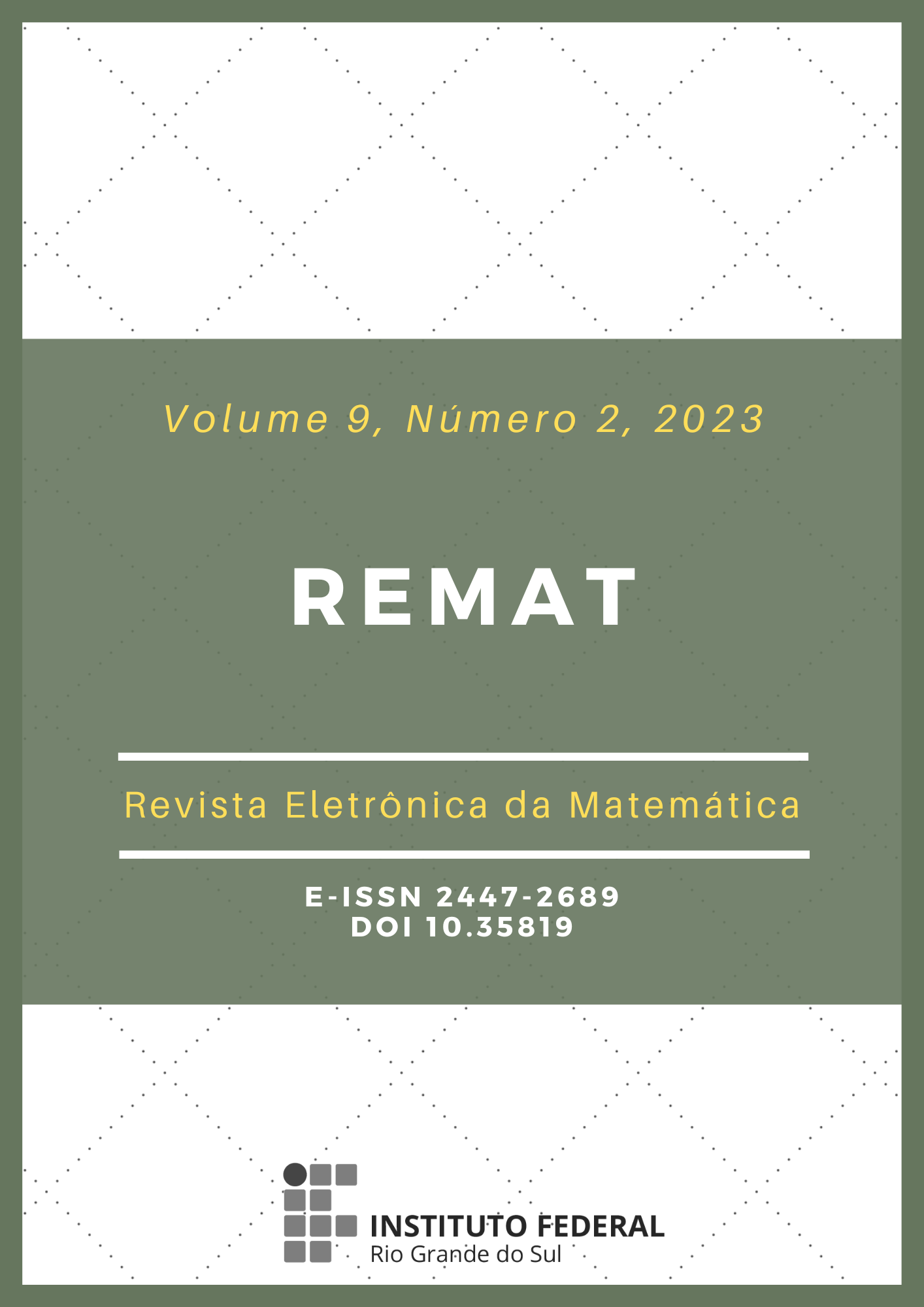Chorin-Teman method: a parallel implementation applied to the cylindrical duct problem via Finite Element Theory by the aid of MATLAB program
DOI:
https://doi.org/10.35819/remat2023v9i2id6686Keywords:
PDE, Navier-Stokes, cylindrical duct, finite element, MATLABAbstract
This work is part of a doctoral research defended in 2022, in Graduate Program in Applied Mathematics at UNICAMP. The text presented here is an approximate numerical solution for Navier-Stokes Equation, in its decoupled form by means of the Chorin-Temam projection method. We use MATLAB in a parallel implementation, with possibility of choosing the processors to carry out the tests. The mesh was generated with the support of GMSH software in its unstructured form, where refined it well to obtain more accurate results. The validation was based on the experiments published by Lienhard (1966), cited by Blevins (2001), for the case of the cylindrical duct, in which we respected the classifications given for the different Reynolds numbers.
Downloads
References
ANTUNES, A. R. E. Um sistema computacional utilizando uma formulação de passo fracionado e o método dos elementos finitos por arestas para a análise de escoamentos incompressíveis tridimensionais usando computação paralela. Orientador: Paulo Roberto Maciel Lyra. 166f. 2008. Tese (Doutorado em Engenharia Civil) - Universidade Federal de Pernambuco, Recife, 2008. Disponível em: https://repositorio.ufpe.br/handle/123456789/4924. Acesso em: 25 out. 2023.
BECKER, E. B.; CAREY, G. F.; ODEN, J. T. Finite Elements: an introduction. Texas: University of Texas, 1981.
BLEVINS, R. D. Flow-Induced Vibration. 2. ed. Malabar, Florida: Krieger Publishing Company, 2001.
CHORIN, A. J. Numerical Solution of the Navier-Stokes Equation. Mathematics of Computation, v. 22, n. 104, p. 745-762, 1968. Disponível em: https://math.berkeley.edu/~chorin/chorin68.pdf. Acesso em: 28 out. 2023.
GEUZAINE, C.; REMACLE, J.-F. A 3-D finite element mesh generator with built-in pre- and post-processing facilities. International Journal for Numerical Methods in Engineering. v. 79, n. 11, p. 1309-1331, 2009. DOI: https://doi.org/10.1002/nme.2579.
GOLDBERG, D.; RUAS, V. A numerical study of projection algorithms in the finite element simulation of three-dimensional viscous incompressible flow. International Journal for Numerical Methods in Fluids. v. 30, n. 3, p. 233-256, 1999. DOI: https://doi.org/10.1002/(SICI)1097-0363(19990615)30:3<233::AID-FLD840>3.0.CO;2-C.
GUEDES, H. A. S. Hidráulica. 1. ed. Pelotas, RS: Universidade Federal de Pelotas, 2018.
HUGHES, T. J. R. The Finite Element Method: Linear Static and Dynamic Finite Element Analysis. 2. ed. New York: University of Stanford, 2000.
KRINDGES, A. Modelagem e simulação computacional de um problema tridimensional de difusão-advecção com uso de Navier-Stokes. Orientador: João Frederico da Costa Azevedo Meyer. 83 f. 2011. Tese (Doutorado em Matemática Aplicada) - Universidade Estadual de Campinas, Instituto de Matemática Estatística e Computação Científica, Departamento de Matemática Aplicada, Campinas, SP, 2011.
LIENHARD, J. H. Synopsis of lift, drag and vortex frequency data for rigid circular cylinders. Bulletin 300. Washigton: Washigton States University, 1966.
SILVA, G. dos S. Modelagem, aproximação numérica e simulação computacional de impacto ambiental em meio fluvial: o Rio Tocantins no município de Imperatriz (MA). Orientador: João Frederico da Costa Azevedo Meyer. 124 f. 2022. Tese (Doutorado em Matemática Aplicada) - Universidade Estadual de Campinas, Instituto de Matemática Estatística e Computação Científica, Departamento de Matemática Aplicada, Campinas, SP, 2022. Disponível em: https://www.ime.unicamp.br/pos-graduacao/matematica-aplicada/modelagem-aproximacao-numerica-simulacao-computacional-impacto. Acesso em: 5 nov. 2023.
TEMAM, R. Navier-Stokes Equations. Amsterdan: North-Holland Publishing, 1977.
TRALES, P. R. Resolução das Equações de Navier-Stokes pelo Método das Projeções via Elementos Finitos com Aceleração pelas Técnicas Multigrid. 1995. Tese (Doutorado em Ciência da Computação) - Pontifícia Universidade Católica do Rio de Janeiro, Departamento de Informática, Rio de Janeiro, 1995.
Downloads
Published
Issue
Section
License
Copyright (c) 2023 REMAT: Revista Eletrônica da Matemática

This work is licensed under a Creative Commons Attribution 4.0 International License.
REMAT retains the copyright of published articles, having the right to first publication of the work, mention of first publication in the journal in other published media and distribution of parts or of the work as a whole in order to promote the magazine.
This is an open access journal, which means that all content is available free of charge, at no cost to the user or his institution. Users are permitted to read, download, copy, distribute, print, search or link the full texts of the articles, or use them for any other legal purpose, without requesting prior permission from the magazine or the author. This statement is in accordance with the BOAI definition of open access.













 https://orcid.org/0000-0002-0893-7426
https://orcid.org/0000-0002-0893-7426


















